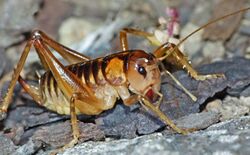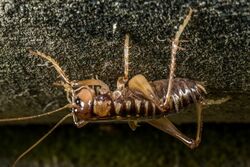Biology:Hemiandrus maia
| Hemiandrus maia | |
|---|---|

| |
| Scientific classification | |
| Domain: | Eukaryota |
| Kingdom: | Animalia |
| Phylum: | Arthropoda |
| Class: | Insecta |
| Order: | Orthoptera |
| Suborder: | Ensifera |
| Family: | Anostostomatidae |
| Genus: | Hemiandrus |
| Species: | H. maia
|
| Binomial name | |
| Hemiandrus maia Taylor Smith, Morgan-Richards, Trewick 2013
| |
Hemiandrus maia, the Otago ground wētā, is a species of ground wētā endemic to New Zealand.[1] Being a ground weta, they are often found in burrows in the ground during the daytime (as they are also nocturnal). The species is occurs on the South Island and is classified as "not threatened".[2] This species of wētā is unusual for an insect in that the female looks after her eggs and nymphs, this is known as maternal care.
Taxonomy
Hemiandrus maia was first described in 2013, but had been referred to in previous publications by an informal (tag) name (Hemiandrus 'evansae').[1][3] The species name comes from the Greek name Maia, the eldest of the Pleiades (in Greek mythology the seven daughters of Pleione and Atlas), meaning 'mother' or 'good mother'. This name is given to this species to reflect the maternal care exhibited.
Habitat/Distribution
Hemiandrus maia are endemic to the South Island of New Zealand. Because they are a ground weta, they are often found in burrows in the ground during the day, as they are a nocturnal species.[4] During the night however, they are quite active on the ground, but are also found in vegetation.
Conservation
The New Zealand Department of Conservation classified this species as "not threatened" in 2014.[2]
Diet
Hemiandrus maia is omnivorous, eating fruit and invertebrates but avoiding seeds of native plants.[1][5]
Morphology
Otago ground wētā females have a medium-length ovipositor.[1] Male and females have fore tibiae with a single superior prolateral spine (excluding apical spine) and mid tibiae with two superior prolateral spines and three superior retrolateral spines (excluding apical spines).
Behavior
Hemiandrus maia come out of their burrows on average once every three nights.[1] The females share burrows and care for eggs and nymphs.[1]
References
| Wikimedia Commons has media related to Hemiandrus maia. |
- ↑ 1.0 1.1 1.2 1.3 1.4 1.5 Smith, BL Taylor; Morgan-Richards, M.; Trewick, SA (2013). "New Zealand ground wētā (Anostostomatidae: Hemiandrus): descriptions of two species with notes on their biology" (in en). New Zealand Journal of Zoology 40 (4): 314–329. doi:10.1080/03014223.2013.804422. ISSN 0301-4223.
- ↑ 2.0 2.1 Steve Trewick; Peter Johns; Rod Hitchmough; Jeremy Rolfe; Ian Stringer (2014). The conservation status of New Zealand Orthoptera, 2014. https://www.doc.govt.nz/Documents/science-and-technical/nztcs16entire.pdf.
- ↑ Johns, Peter (2001). "Distribution and conservation status of ground weta, Hemiandrus species (Orthoptera: Anostostomatidae)". Science for Conservation 180. https://www.doc.govt.nz/documents/science-and-technical/Sfc180.pdf.
- ↑ Gwynne, D. T. (2014). "A secondary copulatory structure in a female insect: a clasp for a nuptial meal?". Naturwissenschaften 89 (3): 125–127. doi:10.1007/s00114-002-0298-y. PMID 12046632.
- ↑ Morgan-Richards, Mary (2008). "When is it coevolution? The case of ground wētā and fleshy fruits in New Zealand" (in en). NZES. https://newzealandecology.org/nzje/2843.
Wikidata ☰ Q21267758 entry
 |


